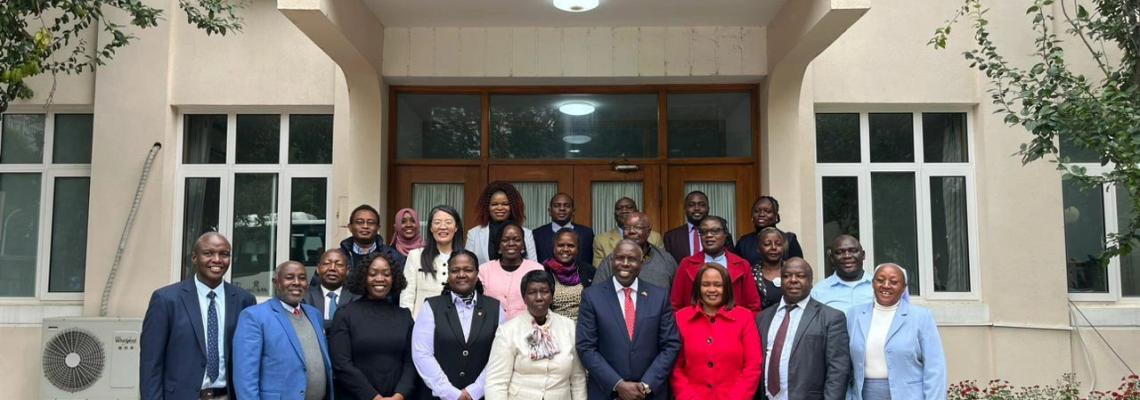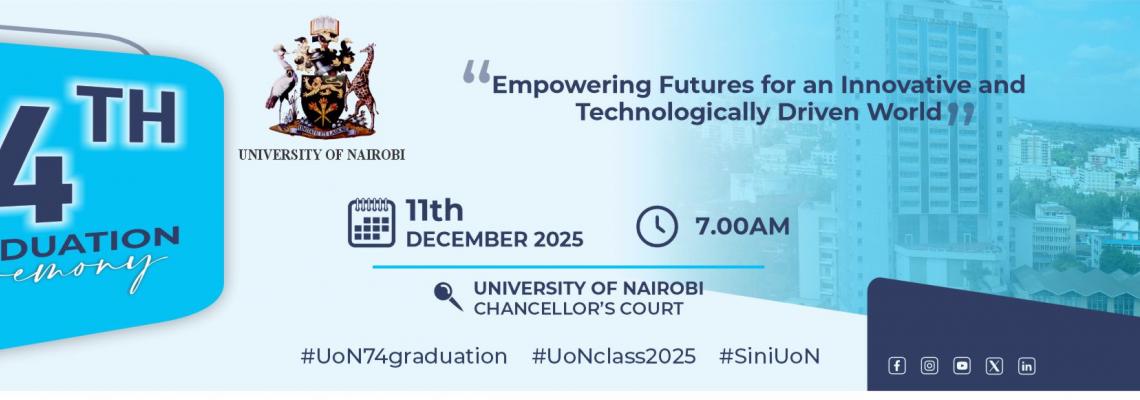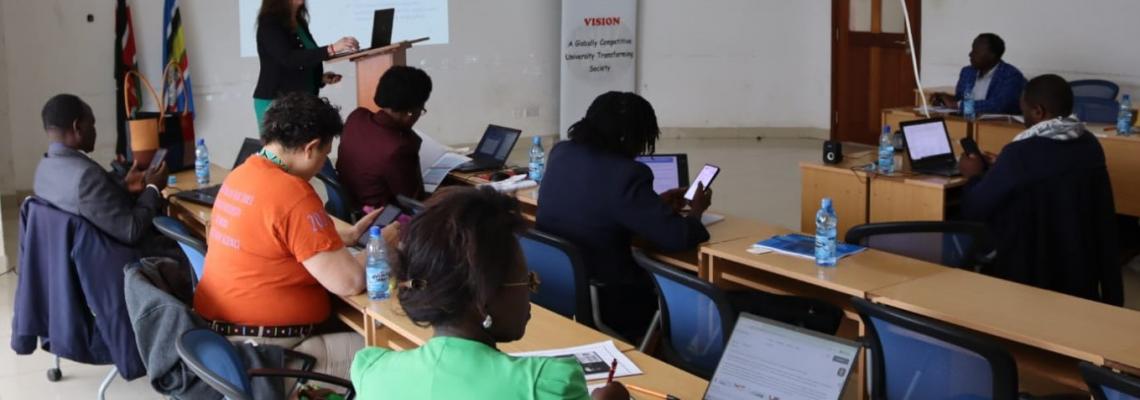HISTORICAL PERSPECTIVE AND STRUCTURAL SETTING
The history of professional training of graduate teachers in Kenya dates back to 1972 when the Faculty of Education was established in the University of Nairobi with assistance from UNESCO. The intention was to provide a broad education background and professional training, appropriate for teaching at the secondary school level as well as teacher education at the tertiary level. This intention was halted in 1978, when the said Faculty was transferred to Kenyatta University College, which was then a constituent college of the University of Nairobi. In 1985, Kenyatta University received its orders to operate as an autonomous institution of higher learning, an independent University. This meant that the University of Nairobi was left without one of its very popular programmes and a voice in shaping the future human resource development in Kenya.
As the premier institution, the University of Nairobi needed to be at the forefront of setting the pace in the development of education sciences. Thus, in 1988, the University of Nairobi re-created the Faculty of Education within the College of Adult and Distance Education. For better and effective management, the College was then re-organized, re-structured and renamed the College of Education and External Studies (CEES) with the following three faculties: Faculty of Education, Faculty of External Studies (later renamed School of Continuing and Distance Education) and Faculty of Social Sciences. The first cohort of 460 students was admitted to the Faculty of Education in 1988 to pursue the Bachelor of Education (B.Ed) Arts degree. The Faulty of Education provided the professional teacher competence skills, while the subject content areas of the programme were provided by the Faculty of Social Sciences.
In the year 2000, the Faculty introduced the B.Ed (Science) degree programme. This was done in order to meet the demand for science teachers in the country, the objective being to fill the human resource gap observed in the secondary school sub sector. A structural change introduced in 2005 saw the establishment of the School of Education to replace the Faculty of Education, while the Faculty of Social Sciences was disbanded and staff deployed to other faculties in the University. The Centre for Open and Distance Learning (CODL) was also established as a Unit under CEES. The Sports Sciences were later introduced in the School during the same year as a teaching department which was intended to train physical education teachers, instructors, sports and physical fitness managers. The Department has since grown and is proposed to become the School of Physical Education and Sports Sciences.
In May 2007, the Public Universities Inspection Board recommended that the then Kenya Science Teachers College (KSTC) be made part of the University of Nairobi in order to boost the efforts of the College in training teachers in Science Education at graduate level. The government approved the recommendation and in October 2007, KSTC was handed over to the University and renamed Kenya Science Campus. The Kenya Science Campus has to date tremendously enhanced the science and technology teacher education training with the view of contributing to the achievement of the Kenya vision 2030. Indeed, it is from the Kenya Science Campus that the B.Ed. (Science) and the B.Ed. ((Information Communication Technology) – popularly known as the B.Ed. (ICT) programmes are offered. The latter programme was developed in 2010 and received its first cohort of 21 government sponsored students in 2012.
In the year 2017 another structural change resulted in the creation of the ODeL campus by the University of Nairobi to manage the Open and e-Learning modes of delivery in conjunction with the schools and faculties.
Consequently, the School of Continuing and Distance Education as well as CODL were absorbed by ODeL Campus.
This necessitated a review of the functions and nomenclature of the College which is still in progress. The College has a regional outreach through the University of Nairobi Campuses of Kisumu and Mombasa. Currently, we have postgraduate students based at Kisumu Campus pursuing programmes in the departments of Educational Foundations, Educational Administration and Planning, as well as Educational Communication and Technology.
FLASHBACK
The College of Education and External Studies (CEES) which has become a key player in training of teachers and other human resource that manage and ensure successful performance in the Education Sector in Kenya, has a rich history which can be traced through the following time capsule:
1953: The Department of Extra Mural Studies (DEMS) of Makerere University is established in Kenya at Koibatek in Baringo County.
1956: The First Resident Tutor for Kenya, Prof. Okot p’Bitek is appointed.
1963: Organization of Extra Mural activities transferred to Kenya under a newly established DEMS at the Royal Technical College Nairobi. In the same year the College of Social Studies at Kikuyu is absorbed into the Royal Technical College and merged with DEMS to form the Institute of Adult Studies (IAS)
1967: The Institute of Adult Studies merges with Correspondence Course Unit (CCU) to form 3 departments: Department of Extra Mural Studies (DEMS), Adult Studies, and Correspondence Courses - Many will remember Macharia Kiruhi and his Adult Studies Classroom; Thomas Mulusa of the Extra-Mural Studies fame; and Khalfan Mazrui with the famous Correspondence Courses.
1970: The University of East Africa is dissolved and the three East African countries set up their own individual national Universities. This development saw the University of Nairobi set up by an Act of Parliament.
1972: The Faculty of Education is established at the University of Nairobi, Main Campus with assistance from UNESCO. The Bachelor of Education (B.Ed.) programme, which had been developed and launched at the Royal Technical College in 1966, is transferred to the new Faculty of Education in the present Education Building.
1978: The Faculty of Education is transferred to Kenyatta University College, the first Constituent College of the University of Nairobi, leaving a hiatus of teacher training at the University of Nairobi.
1983: The Institute of Adult Studies earlier established in 1983 is accorded College status and is renamed College of Adult and Distance Education (CADE). CADE is then restructured to create 2 faculties: the Faculty of External Studies and Faculty of Social Sciences. Many will remember Peter E. Kinyanjui, the Principal of CADE at the time.
1985: Kenyatta University College becomes a full-fledged public University in Kenya and adopts the name …Kenyatta University (KU).
1988: After a 10-year absence, the Faculty of Education is re-created in the University of Nairobi and domiciled within the College of Adult and Distance Education For better and effective management, the College is then re-organized, re-structured and renamed the College of Education and External Studies (CEES) with the following three faculties: Faculty of Education, Faculty of External Studies (later renamed School of Continuing and Distance Education), and Faculty of Social Sciences. These were later joined by the Centre for Open, and Distance Learning (CODL) in 2005 many will remember the indomitable Prof. Floridah Karani who was the First Principal of CEES until 1994 when she was succeeded by Prof. Lucia Omondi (1994 – 2004) as Prof. Karani proceeded to become the first female Deputy Vice-Chancellor in charge of Academic Affairs (1994 – 2004) and much later, the Chancellor of Maseno University (2008 – 2014).
2005: The Faculty of Education transforms itself into the School of Education; while the Faculty of Social Sciences is disbanded and merged with other faculties in the University. In the same year the Centre for Open and Distance Learning is established, and the Sports Sciences discipline introduced in the School of Education as a teaching department with intent to train physical education teachers, instructors, sports and physical fitness managers. Prof. H. W. Mutoro is appointed Principal of the College (2005 – 2014).
2006: College purchases the British Council Library plot in Kisumu, which becomes the Kisumu Extra Mural Centre. The plot is later developed by the University to become the present vibrant Kisumu Campus Complex.
2007: The Public Universities Inspection Board recommends that the then Kenya Science Teachers College (KSTC) be made part of the University of Nairobi in order to boost the efforts of the College in training teachers in Science Education at graduate level. The government approves the recommendation and in October 2007, KSTC is handed over to the University, to become the Kenya Science Campus under CEES, with Prof. Isaac Jumba being appointed as the first Deputy Principal.
2009: CEES teams up with College of Humanities and Social Sciences to purchase the Uni Plaza Mombasa Building which is now the vibramtMombasa Campus.
2015: To enable academic staff of the University of Nairobi become competent in the art and science of teaching their various disciplines through capacity building and continuous professional development programmes the Centre for Pedagogy and Andragogy (CEPA) is created and domiciled in CEES with the Secretariat located at Kenya Science Campus.
2016: Another structural change results in the creation of ODeL Campus by the University of Nairobi, to manage the Open and e-Learning modes of delivery in conjunction with the various schools, faculties and institutes. The School of Continuing and Distance Education as well as CODL are transferred to ODeL Campus, which becomes operationalized in February 2017.
2019: Senate upholds the decision to operationalise the Institute of Educational Research and Evaluation (IERE) which had been approved in the year 2010. In addition, the Senate approves the elevation of the Department of Physical Education and Sport into a fully functioning and vibrant School of Physical Education and Sports Sciences. Further, the Senate also approves the creation of the Centre for STEAM and TVET Education (CESTE) and Early Grade Reading Institute (EGRI) as units under CEES, in order to boost the training of teachers for the TVET and Early Years learning pathways, respectively. These new changes are awaiting Council approval. The new developments further underscore the need for a review of the functions and nomenclature of the College. This is in progress.
2020: College celebrates 50 years of Excellence in Teacher Training and teacher professional development at the University of Nairobi.







